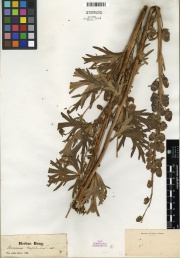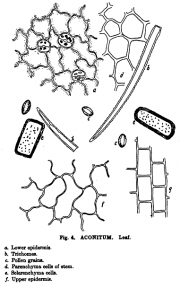Aconitum napellus (leaf)
(Nomenclature updated) |
(new template, organoleptic section separated out) |
||
| Line 1: | Line 1: | ||
| − | = | + | {{DISPLAYTITLE:'' Aconitum napellus'' (leaf) }} |
| − | + | =Nomenclature= | |
{{nomenclature | binomial=Aconitum napellus | {{nomenclature | binomial=Aconitum napellus | ||
|authority=L. | |authority=L. | ||
| Line 11: | Line 11: | ||
|notes= }} | |notes= }} | ||
| − | = | + | =Botanical Voucher Specimen= |
| − | + | ||
| − | + | ||
| − | + | ||
| − | + | ||
| − | + | ||
| − | + | ||
| − | + | ||
| − | + | ||
{{Macroscopy | source=MOBOT, Tropicos.org | {{Macroscopy | source=MOBOT, Tropicos.org | ||
| Line 30: | Line 22: | ||
| }} | | }} | ||
| − | =Microscopic | + | =Organoleptic Characteristics= |
| + | {{Macroscopy | source=United States Dispensatory (1918) | ||
| + | | description="[''Aconitum Napellus''] seeds are ... very acrid. | ||
| + | |||
| + | "The fresh leaves have a faint narcotic odor, most sensible when they are rubbed. Their taste is at first bitterish and herbaceous, afterwards burning and acrid, with a feeling of numbness and tingling on the inside of the lips, tongue, and fauces, which is very durable, lasting sometimes many hours. When long chewed, they inflame the tongue. The dried leaves have a similar taste, but the acrid impression commences later."}} | ||
| + | =Macroscopic Characteristics= | ||
| + | |||
| + | {{Macroscopy | source=United States Dispensatory (1918) | ||
| + | | description="''Aconitum Napellus'' is a perennial herbaceous plant, | ||
| + | with a conical- shaped, tapering root, seldom exceeding 10 cm. in length and 2 cm. in thickness near the summit, brownish externally, whitish and fleshy within, and sending forth numerous long, thick, fleshy rootlets. When the plant is in full growth, there are usually two roots joined together, of which the older is dark brown and supports the stem, while the younger is of a light yellowish-brown, and is destined to furnish the stem of the following year, the old root decaying. | ||
| + | |||
| + | "The stem is erect, round, smooth, leafy, usually simple, and from two to six or even eight feet high. The leaves are alternate, petiolate, divided almost to the base, from two to four inches in diameter, deep green upon their upper surface, light green beneath, somewhat rigid, and more or less smooth and shining on both sides. Those on the lower part of the stem have long footstalks and five or seven divisions; the upper, short footstalks and three or five divisions. The divisions are wedge-form, with two or three lobes, which extend nearly or quite to the middle. The lobes are cleft or toothed, and the lacinise or teeth are linear or linear-lanceolate and pointed. The flowers are of a dark violet-blue color, large and beautiful, and are borne at the summit of the stem upon a thick, simple, straight, erect, spike-like raceme, beneath which, in the cultivated plant, several smaller racemes arise from the axils of the upper leaves. Though without calyx, they have two small calycinal stipules, situated on the peduncle within a few millimeters of the flower. The petals are five, the upper helmet-shaped and beaked, nearly hemispherical, open or closed, the two lateral roundish and internally hairy, the two lower oblong-oval. They enclose two pediceled nectaries, of which the spur is capitate, and the lip bifid and revolute. The fruit consists of three, four, or five follicles. The seeds are wrinkled or scaly ..."}} | ||
| + | |||
| + | =Microscopic Characteristics= | ||
{{Microscopy | source=Schneider, A. (1921) The Microanalysis of Powdered Vegetable Drugs, 2nd ed. | {{Microscopy | source=Schneider, A. (1921) The Microanalysis of Powdered Vegetable Drugs, 2nd ed. | ||
| Line 43: | Line 48: | ||
| }} | | }} | ||
| − | = | + | =High Performance Thin Layer Chromatographic Identification= |
| − | = | + | |
| + | =Supplementary Information= | ||
| + | |||
| + | =Sources= | ||
| + | |||
| + | <references /> | ||
Revision as of 19:47, 13 March 2014
Contents |
Nomenclature
Aconitum napellus L. Ranunculaceae
Standardized common name (English): aconite
Botanical Voucher Specimen
|
Organoleptic Characteristics
|
Macroscopic Characteristics
|
Microscopic Characteristics
|
High Performance Thin Layer Chromatographic Identification
Supplementary Information
Sources
- ↑ MOBOT, Tropicos.org http://www.tropicos.org/Image/100190599
- ↑ United States Dispensatory (1918)
- ↑ United States Dispensatory (1918)
- ↑ Schneider, A. (1921) The Microanalysis of Powdered Vegetable Drugs, 2nd ed.

